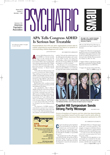Ever since the 1970s, certain people have been known to be anxiety repressors. That is, their heart rate, blood pressure, muscle tone, and other physiological measures reveal that they experience anxiety, yet they manage to repress conscious thoughts about their anxiety.
What’s more, persons who have had heart attacks are known to be in danger of both acute stress disorder and posttraumatic stress disorder (PTSD).
Thus, some Israeli researchers decided to conduct a study to find out how good an anxiety-repression coping style is at shielding patients from acute stress disorder and from PTSD. As they reported in the September/October Psychosomatic Medicine, the coping style seems to be effective.
Karni Ginzburg, Ph.D., a lecturer at Tel Aviv University School of Social Work; Zahava Solomon, Ph.D., a professor there; and Avi Bleich, M.D., chair of psychiatry, selected as their subjects more than 100 patients who had been hospitalized for a heart attack. While the subjects were hospitalized, they filled out a 58-item psychological questionnaire to reveal whether they were anxiety types (persons who feel anxious when threatened with dangerous situations), defensive types (individuals who try to repress their anxiety but fail), successful anxiety-repression types (individuals who tend to repress their anxiety and succeed at it), or low-anxiety types (persons who experience little anxiety when faced with threatening situations).
While in the hospital, the subjects were also assessed with the Stanford Acute Stress Reaction Questionnaire, which is based on DSM-IV criteria, to determine whether they were suffering from acute stress disorder. Seven months later, they were evaluated at home with the PTSD Inventory, a self-report questionnaire based on DSM-IV criteria, to determine whether they had PTSD.
As Ginzburg explained to Psychiatric News, clinical interviews are definitely preferred when a diagnosis of PTSD is made for clinical purposes. However, for their study purposes, they believed that their standardized self-report questionnaire was superior, not just because it was easier to administer, but because it had both high validity and high specificity.
After Ginzberg and her coworkers analyzed their data to categorize their subjects in one of the four stress-reaction groups, they determined how many subjects in each succumbed to either acute stress disorders or PTSD. This way they could see how the repressive-coping types compared with the other three types.
They found that 31 percent of their subjects were anxiety types, 26 percent were defensive types, 25 percent were successful anxiety-repression types, and 17 percent were low-anxiety types.
They found that 36 percent of the anxiety types, 21 percent of the defensive types, 4 percent of the successful anxiety-repression types, and none of the low-anxiety types experienced acute stress disorder.
They found that 19 percent of the anxiety types, 17 percent of the failed anxiety-repression types, 7 percent of the successful anxiety-repression types, and 20 percent of the low-anxiety types experienced PTSD.
When Psychiatric News asked Ginzburg whether there might be a contradiction between their finding that no low-anxiety subjects experienced acute stress disorder and their finding that 20 percent of them experienced PTSD, she replied that there was not. The reason, she explained, is that other researchers have found that levels of anxiety experienced immediately after a stressful event are only marginally predictive of whether a person will ultimately experience PTSD.
So, putting all these findings together, they suggest that “the repressive coping style may promote adjustment to traumatic stress, both in the short and longer term,” Ginzburg and her coworkers concluded. In other words, this coping style appeared to be superior to both anxiety and defensiveness in preventing acute stress disorder, and superior to anxiety, defensiveness, and low anxiety in preventing PTSD.
The findings are useful to psychiatrists, Bleich told Psychiatric News, in that they “promote knowledge of the possible psychiatric consequences of myocardial infarction and suggest a direction for early intervention and therapy when needed.”
The study was financed by the Israeli Ministry of Health and the Sarah Peleg Research Foundation.
The study, “Repressive Coping Style, Acute Stress Disorder, and Posttraumatic Stress Disorder After Myocardial Infarction,” is posted on the Web at www.psychosomaticmedicine.org/cgi/content/full/64/5/748. ▪
Psychosomatic Medicine 2002 64 748
